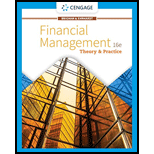
Financial Management: Theory & Practice
16th Edition
ISBN: 9781337909730
Author: Brigham
Publisher: Cengage
expand_more
expand_more
format_list_bulleted
Question
Chapter 8, Problem 4MC
1.
Summary Introduction
Case summary:
Person X was hired by Company T as a financial analyst and he was asked to prepare a brief report which can be used by the executives to attain a cursory understanding on the topic. He used question and answer format to prepare the report. After the questions being drafted person X needs to answer to the questions.
To discuss: The stock price ending values and payoffs of the call option.
2.
Summary Introduction
To determine: The number of shares to buy to create a riskless payoff portfolio and pyof of the portfolio.
3.
Summary Introduction
To determine: The
4.
Summary Introduction
To determine: The replicating portfolio and arbitrage
Expert Solution & Answer
Want to see the full answer?
Check out a sample textbook solution
Students have asked these similar questions
Plz correct answer..
Plz correct answer..
Plz correct solution..
Chapter 8 Solutions
Financial Management: Theory & Practice
Ch. 8 - Define each of the following terms:
Option; call...Ch. 8 - Why do options sell at prices higher than their...Ch. 8 - Describe the effect on a call option’s price that...Ch. 8 - A call option on the stock of Bedrock Boulders has...Ch. 8 - The exercise price on one of Flanagan Company’s...Ch. 8 - Assume that you have been given the following...Ch. 8 - The current price of a stock is $33, and the...Ch. 8 - Use the Black-Scholes model to find the price for...Ch. 8 - The current price of a stock is 20. In 1 year, the...Ch. 8 - The current price of a stock is $15. In 6 months,...
Knowledge Booster
Learn more about
Need a deep-dive on the concept behind this application? Look no further. Learn more about this topic, finance and related others by exploring similar questions and additional content below.Similar questions
arrow_back_ios
SEE MORE QUESTIONS
arrow_forward_ios
Recommended textbooks for you
 Intermediate Financial Management (MindTap Course...FinanceISBN:9781337395083Author:Eugene F. Brigham, Phillip R. DavesPublisher:Cengage Learning
Intermediate Financial Management (MindTap Course...FinanceISBN:9781337395083Author:Eugene F. Brigham, Phillip R. DavesPublisher:Cengage Learning


Intermediate Financial Management (MindTap Course...
Finance
ISBN:9781337395083
Author:Eugene F. Brigham, Phillip R. Daves
Publisher:Cengage Learning

Accounting for Derivatives Comprehensive Guide; Author: WallStreetMojo;https://www.youtube.com/watch?v=9D-0LoM4dy4;License: Standard YouTube License, CC-BY
Option Trading Basics-Simplest Explanation; Author: Sky View Trading;https://www.youtube.com/watch?v=joJ8mbwuYW8;License: Standard YouTube License, CC-BY